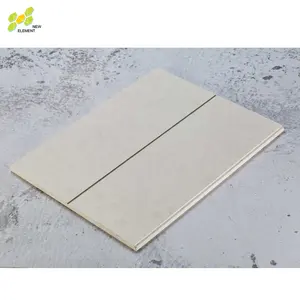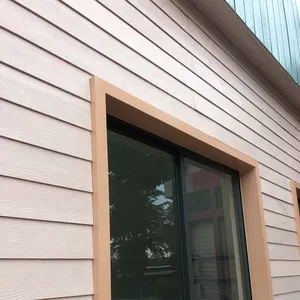(11622 products available)








































































































































































































































A warehouse cladding panel is a type of building component used to create the exterior walls and sometimes roofs of warehouses and other industrial structures. These panels are designed to provide structural support, insulation, and protection from the elements. They consist of two outer metal sheets and an inner core material, which can vary depending on the specific requirements of the warehouse. This includes prefabricated construction, energy efficiency, fire resistance, and cost considerations.
Warehouse cladding panels come in various types, including:
Insulated Metal Panels (IMPs)
These warehouse cladding panels consist of two steel sheets with an insulating foam core. The core is usually polyurethane, which provides high thermal efficiency. IMPs create a sandwich panel design that offers structural integrity and insulation in a single component. These panels are lightweight and easy to install. They also have a high-strength-to-weight ratio. Insulated metal panels provide excellent thermal resistance. They are also cost-effective for large-scale warehouse construction. Additionally, they offer fire resistance and have different finishes to improve aesthetic appearance.
Single Skin Metal Panels
These panels are composed of a single layer of metal, usually steel, aluminum, or galvanized iron. They are lightweight and economical. Additionally, they are easy to install and have low maintenance requirements. Single-skin metal panels provide high durability and can be customized with various coatings. However, they have lower insulation properties when compared to insulated metal panels.
Fiberglass Reinforced Panels (FRPs)
These panels have a metal backing and a layer of fiberglass reinforced plastic on the exterior. The core is usually air or foam. They are lightweight and have high corrosion and chemical resistance. Additionally, they have good aesthetics and are suitable for areas requiring hygiene and easy cleaning.
Polystyrene Panels
These panels consist of two metal sheets with a core of expanded polystyrene foam. They are cost-effective and lightweight. Additionally, they have good thermal insulation properties. Polystyrene panels are suitable for non-refrigerated warehouses and are often used in areas where budget constraints are essential.
Polyurethane Panels
These warehouse cladding panels have a metal exterior and a core of polyurethane foam. They provide high insulation values and have a low U-factor. Polyurethane panels are suitable for temperature-controlled warehouses and have a good strength-to-weight ratio.
Mineral Wool Panels
These insulated cladding panels consist of metal sheets and a core of mineral wool insulation. They are non-combustible and provide excellent soundproofing. Mineral wool panels are suitable for fire-rated applications and provide good thermal insulation.
There are many functions of a warehouse cladding panel and features that make it suitable for use in warehouses. Some of them are:
Structural Support:
A cladding panel performs the function of providing structural support to a warehouse. This is because it is made of strong materials such as steel, aluminum, and galvanized iron that can withstand harsh environmental conditions. Due to their strength, they provide a framework for support and stability.
Insulation:
A warehouse cladding panel provides insulation to warehouses. Some panels, such as PU and PIR panels, have insulation cores that help maintain a steady temperature inside the warehouse. Insulation panels reduce the warehouse's need for artificial heating and cooling, which in turn saves energy costs and makes the environment cleaner.
Protection:
Cladding panels protect warehouses against weather elements like rain, snow, and wind. They also prevent warehouses from being damaged by debris and animals. The panels also prevent warehoused goods from being damaged by UV light because some panels have UV-resistant properties.
Fire Resistance:
Some cladding panels have fire-resistant features that help to stop or slow down the spread of fire. This makes sure that the warehouse and its contents are protected in case of fire. Fire-resistant cladding panels also help to keep the people inside the warehouse safe in case of fire accidents.
Easy Installation:
Most cladding panels are easy to install. They are prefabricated, which means they are made before time and then installed. This reduces the time and cost used for construction. Cladding panels are also easy to maintain and repair, which makes them a good choice for warehouse construction.
Durability:
Cladding panels are made from strong materials, as stated above. They can withstand harsh environmental conditions like extreme weather, corrosion, and impact. Once they are properly maintained, they can last for a long time. This makes them a cost-effective option for building warehouses.
Versatility:
Cladding panels come in different materials, sizes, and designs. This makes them suitable for different types of warehouses and other uses. Panel cladding can be adapted to meet the needs of different customers, making it a preferred choice for many people.
Warehouse cladding panels offer a variety of applications due to their durability, insulation properties, and cost-effectiveness. Here are some common usage scenarios:
Storage Facilities
Warehouse cladding panels are commonly used in the construction of self-storage units and traditional storage warehouses. The panels provide a secure and weather-resistant environment for stored goods. They also offer insulation, which helps maintain a stable temperature in climate-controlled storage units.
Retail Warehouses
Cladding panels are used in retail warehouses, also known as big-box stores. The panels create large, open spaces for the storage of retail merchandise, such as home improvement products, electronics, and appliances. Their quick and easy construction helps reduce initial store construction time.
Cold Storage Facilities
Cold storage warehouses, including refrigerated and freezer storage, rely on cladding panels for insulation. The panels help maintain specific temperature ranges necessary for perishable goods, such as food items and pharmaceuticals, to be stored safely and transported.
Distribution Centers
Cladding panels are used in distribution centers due to their large storage capabilities. They provide shelter and protection for goods before they are redistributed. The panels also create loading docks, storage areas, and office spaces for efficient warehouse operations.
Manufacturing Warehouses
Cladding panels provide a versatile solution for manufacturing warehouses. The panels create large open spaces for the storage of finished products, raw materials, and manufacturing equipment. They are also easy to customize for specific requirements, such as additional loading docks and high ceilings.
Agricultural Storage
Cladding panels are used in agricultural storage facilities, such as grain silos and equipment sheds. The panels protect farm equipment and harvests from harsh weather conditions, ensuring they remain in good condition for extended periods. The panels are also weather-resistant and durable, making them suitable for agricultural use.
Workshops and Garages
Cladding panels are used in the construction of large workshops and garages. The panels provide a secure environment for storing large vehicles, machinery, and tools. They are also weather-resistant and durable, ensuring the stored items are in good condition for an extended period.
Choosing the right warehouse cladding panels involves considering several factors to ensure the selected panels meet the required functional and operational needs. Here are some of them:
Consider the Type of Cladding
The first step in choosing the right cladding is to look at the type of cladding. There are various types of claddings, such as single-skin, double-skin, insulated, and composite panels. Understanding the purpose of the warehouse and the type of cladding needed is important. For example, a single-skin panel could suffice for a warehouse needing only storage space. However, a double-skin insulated panel would be a better choice if the warehouse stored temperature-sensitive goods.
Evaluate the Material
The material used to manufacture cladding panels greatly impacts their durability, maintenance, and cost. Common materials include galvanized steel, aluminum, and fiberglass. Steel is a popular choice because of its strength and cost-effectiveness. At the same time, aluminum is preferred for its lightweight and rust-resistant properties. It is important to assess the long-term benefits of each material before making a decision.
Assess the Insulation Value
If the warehouse needs to maintain specific temperatures, choosing a cladding panel with good insulation properties is important. Insulated panels with a polyurethane or polystyrene core offer excellent thermal resistance. When assessing insulation, look at the panel's R-value, which measures its insulation effectiveness. A higher R-value indicates better insulation.
Check the Fire Rating
All warehouse cladding panels are not created equally when protecting against fire. If the warehouse stores flammable materials, choose panels with a high fire rating. Fire-rated panels have mineral-filled cores that meet building codes and regulations for fire safety.
Look at the Cost
While the upfront cost of the cladding is an important factor, it should not be the only one. Sometimes, the cheapest option is not the best in the long run. Consider the lifespan, maintenance costs, and energy efficiency of each panel type. An insulated double-skin panel may have a higher upfront cost but could save money over time by reducing heating and cooling costs.
Examine the Aesthetics
While functionality is the primary concern, the appearance of the warehouse should also be considered, especially if clients will visit. Look at the color, texture, and profile of the cladding panels. Profile sheets give the warehouse a more finished look than flat panels.
Q1. What are the three types of warehouse cladding panels?
A1. There are three types of warehouse cladding panels, including:
The single skin panel has a single layer of metal, making it lightweight and cheap. It is suitable for non-walled uses like canopies, fences, and interior partitions.
The insulated panels have foam insulation sandwiched between two metal sheets. They provide temperature control, come in various thicknesses, and are ideal for walls and roofs.
The composite panels have two metal layers enclosing a non-foam core. They offer durability, good insulation, and a neat appearance. They are used for high-end warehouses and insulated walls and roofs.
Q2. What are the 4 types of cladding?
A2. Cladding refers to covering the exterior of a structure. It comes in four types::
The warehouse wooden cladding panels, including cedar, redwood, and engineered wood, are durable and have a natural aesthetic. The vinyl ones are synthetic and come in different textures that mimic wood. They are low-maintenance and weather-resistant. The metal warehouse cladding panels, usually aluminum, steel, or copper, have a sleek modern appearance and are long-lasting. The masonry cladding is brick or stone. It provides a traditional look and requires little maintenance.
Q3. What are the two types of panel cladding?
A3. There are two main types of panel cladding. These include:
The metal wall panels. They have a long lifespan and require low maintenance. They are also energy efficient. They include steel, aluminum, copper, and zinc panels. The other type is the interior decorative wall panels. They improve the aesthetics of the interior space. They come in many materials, such as wood, metal, 3D panels, PVC, and fabric.
Q4. What is the difference between a composite and an insulated panel?
A4. Composite panels have a core bonded by metal sheets. They are strong and provide good insulation. The insulated panels have a foam core between metal sheets. They are specifically designed for insulation.
Q5. What is the difference between wall panels and cladding?